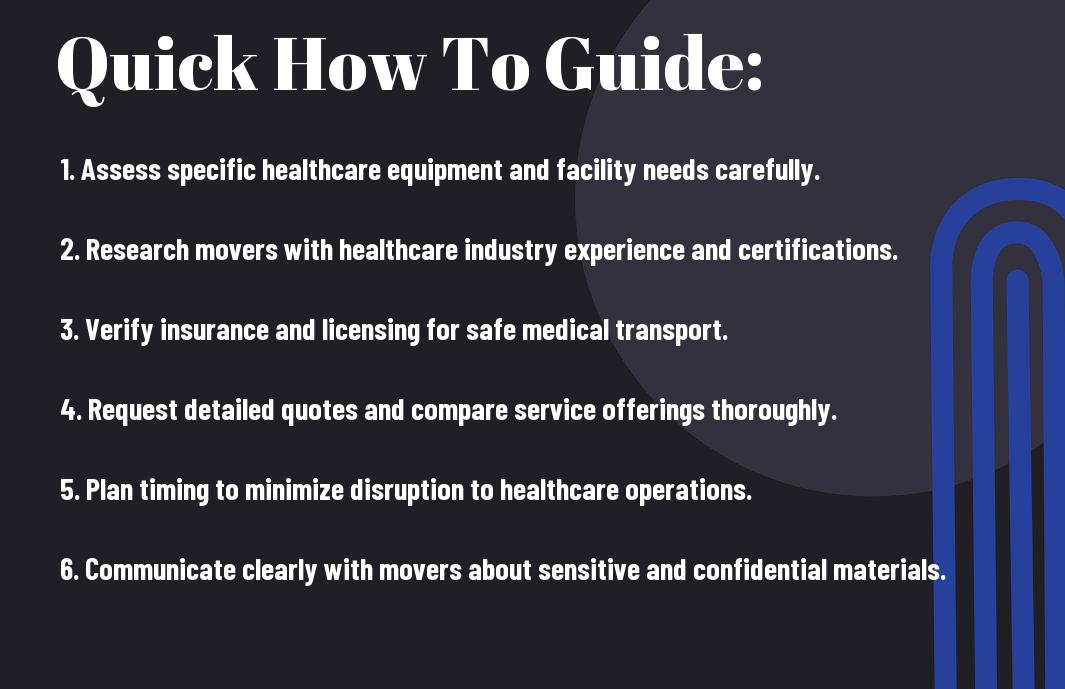Moving your healthcare facility requires careful consideration to ensure that patient care remains uninterrupted and equipment is handled safely. As you assess your options, it’s vital to evaluate various moving solutions tailored to your specific needs. In this guide, you’ll discover key factors to consider, from logistics and regulatory compliance to the right type of moving company. By following these steps, you can streamline your relocation process and set your healthcare provider up for continued success in new surroundings.

Pinpointing Unique Healthcare Needs
Understanding the distinct needs of your healthcare facility is crucial for a successful move. Each healthcare provider has different specialties, which can influence the type of equipment and personnel that must be maintained during the transition. For instance, if you’re handling a hospital with a strong focus on surgical care, specific surgical items and sterile environments must be prioritized during the relocation process to avoid any risk to patient safety.
Evaluating Patient Care Requirements
Your primary focus should always be on patient care requirements. When planning your move, assess how the change will affect patient comfort and access to necessary services; this includes considering proximity to pharmacies, imaging centers, or specialty clinics. Any disruption in care should be minimized to uphold the quality of services that your patients rely on.
Assessing Facility Specifications
Analyzing the architectural layout and logistics of both the current and new facilities forms a significant part of your moving plan. Specifications such as elevator access, door widths for medical equipment, and compliance with healthcare regulations should be thoroughly evaluated to ensure a seamless transition.
For instance, if your new facility has narrower hallways, you may need to rethink how you transport larger equipment, ensuring that it can fit through all access points without damage. Moreover, compliance with the Americans with Disabilities Act (ADA) must also be addressed—make certain that all areas are accessible to patients with mobility challenges. Consider creating a checklist that outlines specific requirements as detailed by any regulatory bodies relevant to your institution, which will help minimize any potential issues that could arise from inadequate planning.
The Economic Landscape of Moving Solutions
Understanding the economic landscape of moving solutions for healthcare providers involves more than just the initial price tag. Various factors, such as the growing demand for healthcare services, fluctuations in the logistics market, and the specific requirements of medical equipment transport, can influence costs. Planning and budgeting effectively can mitigate unexpected expenses while maximizing the efficiency of your move. In this context, realizing the potential return on investment (ROI) from a well-chosen moving solution becomes integral for sustainable growth in your healthcare practice.
Balancing Cost and Quality
Finding the right balance between cost and quality in moving solutions requires a careful evaluation of service providers. The cheapest option may not ensure the protection of delicate medical equipment, while more expensive services might offer amenities that aren’t necessary for your needs. Assess the reliability, experience, and customer feedback of moving companies to make an informed decision that safeguards both your budget and the quality of service you receive.
Understanding Hidden Fees and Additional Expenses
Hidden fees and additional expenses can significantly impact your overall moving budget. These may include charges for packing materials, unexpected labor costs, insurance upgrades, and transportation surcharges. Always ask potential movers for a detailed breakdown of costs to identify potential hidden fees that could inflate your moving expenses.
Your contract with a moving company should ideally stipulate everything, but it’s vital to scrutinize fine print and clarify all possible charges upfront. For instance, charges for delays, additional mileage, or even fuel costs can accumulate quickly if not thoroughly understood. Prioritizing transparency in negotiations ensures you can budget accurately and avoid financial surprises during or after the move. For healthcare providers, where safeguarding assets and managing costs are vital, gaining clarity on these aspects can lead to more favorable outcomes in your relocation efforts.
Evaluating Potential Moving Partners
Finding the right moving partner for your healthcare facility can significantly impact your operations. Start by assessing their experience in healthcare relocations, as specialized knowledge about handling medical equipment and sensitive materials is imperative. Pay attention to their reputation within the industry, as feedback from other healthcare providers can provide insights into reliability and professionalism.
Key Qualities to Look for in a Moving Company
Focus on a few key qualities that can ensure a smooth relocation. Look for a proven track record in managing healthcare moves, offering insurance coverage, and maintaining dedicated teams trained to handle sensitive medical equipment. Additionally, a company with flexible scheduling options can accommodate your operational needs while minimizing downtime.
Questions to Ask Before Hiring
Before making your final decision, engaging with potential moving partners through specific questions can clarify expectations and capabilities. Inquire about their experience with healthcare providers, strategies for managing sensitive equipment, and their approach to unexpected challenges during the move.
In your discussions, prioritize questions that detail their familiarity with regulatory compliance and industry standards related to healthcare moving. Asking about their inventory tracking systems and the protocols they follow to ensure equipment safety can yield valuable insights. For example, inquire about any certifications they possess, such as licensure for transporting controlled substances or specialized training for handling medical devices. These answers will help you evaluate not just their skills but their commitment to supporting your healthcare operations seamlessly.
Navigating Compliance and Regulations
Compliance with regulations is imperative for healthcare providers during a move. Each healthcare facility must adhere to specific laws that govern the handling and transportation of sensitive materials, patient records, and medical supplies. Staying informed about these regulations allows you to select moving solutions that not only keep your operational needs in mind but also align with legal requirements, protecting your facility from potential fines or reputational damage.
Regulations Specific to Healthcare Providers
Healthcare providers must navigate a complex web of regulations, such as HIPAA, which protects patient confidentiality. When moving, your organization must ensure that all medical records, prescriptions, and patient data are securely managed during transportation. Additionally, state-specific regulations regarding the handling of medical equipment and pharmaceuticals can vary significantly, necessitating careful planning and knowledge of compliance obligations.
Ensuring Confidentiality and Safety during the Move
Protecting patient confidentiality and ensuring safety during a move requires meticulous planning. Secure transport methods for sensitive documents and data, along with employee training on confidentiality measures, can safeguard your patients’ information. Utilize sealed containers for records, employ secure digital methods for electronic data, and ensure that moving teams understand the importance of adhering to compliance standards throughout the relocation process.
Implementing safeguards during your move is not only about physical security but also involves creating protocols for accessing sensitive material. For instance, restrict access to designated personnel only during transportation, and maintain a detailed inventory of what is being moved. Conducting a pre-move audit of all confidential materials is beneficial, as it highlights potential vulnerabilities and allows you to formulate a solid action plan. Furthermore, post-move evaluations help to ensure compliance is consistently maintained at your new location, reinforcing your commitment to patient safety and confidentiality.

Creating a Strategic Moving Plan
A well-structured moving plan outlines the steps necessary to ensure a seamless transition for your healthcare facility. Begin by assessing your current operations, inventory, and equipment, categorizing items based on their importance and fragility. This organized approach will not only facilitate a smoother move but will also help minimize disruptions to patient care and staff workflow during the relocation process.
Timeline Management and Coordination
Establishing a clear timeline is crucial for coordinating all moving activities efficiently. Identify critical milestones, such as securing moving permits, packing schedules, and deadlines for setting up the new location. Regular progress check-ins will ensure the timeline remains on track, allowing for timely adjustments when unexpected challenges arise.
Involving Staff and Stakeholders in the Process
Engaging your staff and key stakeholders throughout the moving process fosters transparency and collaboration. By involving everyone in discussions about timelines, workflows, and equipment handling, you empower your team, which can lead to greater buy-in and commitment to the move.
Encouraging input from staff at various levels creates a sense of ownership and responsibility for the transition. Consider hosting regular update meetings to share progress and solicit feedback—this might reveal insights that can improve the logistics of the move. Additionally, the involvement of stakeholders such as department heads and technical teams ensures that all perspectives are considered, ultimately contributing to a more efficient and effective relocation process. A proactive approach not only reduces resistance to change but enhances the overall morale of your team as they collaboratively navigate this significant transition.
Final Words
So, when selecting the right moving solutions for your healthcare facility, prioritize providers with relevant experience, necessary equipment, and strong compliance with industry regulations. Assess their reputation and references to ensure reliability, while also considering their ability to tailor services to your specific needs. Always ask about their safety protocols and insurance coverage to protect your valuable medical equipment. Ultimately, choosing the right moving partner empowers you to facilitate a seamless transition, helping you maintain the high standards of care that your patients deserve.




